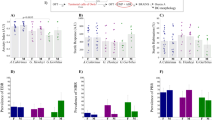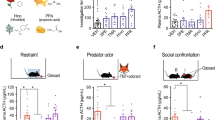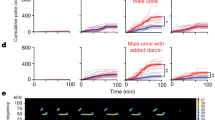Abstract
In stressful situations, many animals release alarm pheromones to warn conspecifics of impending danger. The authors sought to establish experimental conditions for a larger study aimed at identifying alarm pheromones emitted by the rat. They placed rats in a specially designed chamber and exposed them to aversive tactile, visual and acoustic stimuli over the course of a few days. The researchers observed rats' behavior and analyzed air samples taken from their immediate environment under the following conditions: (i) when rats were unstressed; (ii) immediately after rats were exposed to aversive stimuli; and (iii) when rats were left alone in the chamber after being conditioned to fear imminent aversive stimuli. Stressed rats emitted several substances that are known to function as alarm pheromones in insects. When previously unstressed control rats were exposed to these same substances, they had a distinct behavioral fear response.
This is a preview of subscription content, access via your institution
Access options
Subscribe to this journal
We are sorry, but there is no personal subscription option available for your country.
Buy this article
- Purchase on Springer Link
- Instant access to full article PDF
Prices may be subject to local taxes which are calculated during checkout

Similar content being viewed by others
References
Wheeler, J.W. Insect and mammalian pheromones. Lloydia 39, 53–59 (1976).
McClintock, M.K. On the nature of mammalian and human pheromones. Ann. N. Y. Acad. Sci. 855, 390–392 (1998).
Silvotti, L., Montani, G. & Tirindelli, R. How mammals detect pheromones. J. Endocrinol. Invest. 26, 49–53 (2003).
Brennan, P.A. & Keverne, E.B. Something in the air? New insights into mammalian pheromones. Curr. Biol. 14, 81–89 (2004).
Konopski, L. & Koberda, M. Human Pheromones [Polish] (Scholar, Warszawa, 2003).
El-Sayed, A.M. The Pherobase: Extensive Database of Insect Pheromones and Semiochemicals. (2005) http://pherobase.net/
Pauling, L., Robinson, A.B., Teranishi, R. & Cary, P. Quantitative analysis of urine vapor and breath by gas chromatography. Proc. Natl. Acad. Sci. USA 68, 2374–2376 (1971).
Stevens, D.A. & Saplikoski, N.J. Rats′ reactions to conspecific muscle and blood: evidence for an alarm substance. Behav. Biol. 8, 75–82 (1973).
Stevens, D.A. & Gerzog-Thomas, D.A. Fright reaction in rats to conspecifics tissue. Physiol. Behav. 18, 47–51 (1977).
Kiyokawa, Y., Kikusui, T., Takeuchi, Y. & Mori, Y. Alarm pheromones with different functions are released from different regions of the body surface of male rats. Chem. Senses 29, 35–40 (2004).
Hauser, R., Wiergowski, M., Gos, T., Marczak, M., Karaszewski, B. & Wodniak–Ochocińska, Ł . Alarm pheromones as an exponent of emotional state shortly before death—science fiction or a new challenge? Forensic Sci. Int. 155, 226–230 (2005).
Kiyokawa, Y., Shimozuru, M., Kikusui, T., Takeuchi, Y. & Mori, Y. Alarm pheromone increases defensive and risk assessment behaviors in male rats. Physiol. Behav. 87, 383–387 (2006).
Takefumi, K., Shu, T., Yukari, T. & Yuji, M. Alarm pheromone enhances stress-induced hyperthermia in rats. Physiol. Behav. 72, 45–50 (2001).
Millar, J.G. in Sampling and Sample Preparation in Field and Laboratory (ed. Pawliszyn, J.) 669–697 (Elsevier, Amsterdam, 2002).
Barbier, M. Les pheromones, aspects biochimiques et biologiques (Masson, Paris, 1982).
Wood, W.F., Fisher, C.O. & Graham, G.A. Volatile components in defensive spray of the hog–nosed skunk (Conepatus mesoleucus). J. Chem. Ecol. 19, 837–841 (1993).
Wheeler, J.W., Nyalley, L., Davis, D.M. & Weldon, P.J. Additional sulfur compounds from anal glands of striped polecat. Z. Naturforsch. [C] 52, 283–285 (1997).
Regnier, F.E. & Law, J.H. Insect pheromones. J. Lipid Res. 9, 541–551 (1968).
Howe, N.R. & Sheikh, Y.M. Anthopleurine: a sea anemone alarm pheromone. Science 189, 386–388 (1975).
Pfeiffer, W., Riegelbauer, G., Meier, G. & Scheibler, B. Effect of hypoxantine-3(N)-oxide and hypoxantine-1(N)-oxide on central nervous excitation of the black tetra Gymnocorymbus ternetzi (Characidae, Ostariophysi, Pisces) indicated by dorsal light response. J. Chem. Ecol. 11, 507–523 (1985).
Brown, G.E., Adrian, J.C., Naderi, N.T., Harvey, M.C. & Kelly, J.M. Nitrogen oxides elicit antipredator responses in juvenile channel catfish, but not in convict cichlids or rainbow trout: conservation of the ostariophysan alarm pheromone. J. Chem. Ecol. 29, 1782–1796 (2003).
Ono, M., Terabe, H., Hori, H. & Sasaki, M. Insect signaling: components of giant hornet alarm pheromone. Nature 424, 637–638 (2003).
Hauser, R., Marczak, M., Karaszewski, B. & Namieśnik, J. A chamber for the testing the release of volatile substances secreted by animals, especially mammals, as exemplified by substances released by rats in response to stress. Instr. Sci. Technol. 33, 541–550 (2005).
Hauser, R., Gos, T., Krzyżanowski, M. & Goyke, E. The concentration of glutamate in cerebral tissue as a factor for the assessment of the emotional state before death. A preliminary report. Int. J. Legal Med. 112, 184–187 (1999).
Hauser, R., Gos, T., Hartwich, J. & Dębińska-Kieć, A. The activity of constitutive nitric oxide synthase in prefrontal cortex of rats as an exponent of emotional state before death. A preliminary report. Neural Plast. 7, 205–211 (2000).
Gos, T., Hauser, R. & Krzyżanowski, M. The post-mortem concentration of glutamate in the structures of rat brain as an exponent of short aversive sensory stimulation preceding death. Forensic Sci. Int. 123, 130–134 (2001).
Gos, T., Hauser, R. & Krzyżanowski, M. Regional distribution of glutamate in the central nervous system of rat terminated by carbon dioxide euthanasia. Lab. Anim. 36, 127–133 (2002).
Laska, M. & Seibt, A. Olfactory sensitivity for aliphatic alcohols in squirrel monkeys and pigtail macaques. J. Exp. Biol. 205, 1633–1643 (2002).
Hernandez-Salazar, L.T., Laska, M. & Rodriguez-Luna, E. Olfactory sensitivity for aliphatic esters in spider monkeys (Ateles geoffroyi). Behav. Neurosci. 117, 1142–1149 (2003).
Laska, M., Wieser, A., Rivas-Bautista, R.M. & Hernandez-Salazar, L.T. Olfactory sensitivity for carboxylic acids in spider monkeys and pigtail macaques. Chem. Senses 29, 101–109 (2004).
Laska, M., Miethe, V., Rieck, C. & Weindl, K. Olfactory sensitivity for aliphatic ketones in squirrel monkeys and pigtail macaques. Exp. Brain Res. 160, 302–311 (2005).
McFarlane, J.E., Steeves, E. & Alli, I. Aggregation of larvae of the house cricket, Acheta domesticus (L), by propionic acid present in the excreta. J. Chem. Ecol. 9, 1307–1315 (1983).
Blatt, S.E., Borden, J.H., Pierce, H.D., Gries, R. & Gries G. Alarm pheromone system of the western conifer seed bug, Leptoglossus occidentalis. J. Chem. Ecol. 24, 1013–1031 (1998).
Wager, B.R. & Breed, M.D. Does honey bee sting alarm pheromone give orientation information to defensive bees? Ann. Entomol. Soc. Am. 93, 1329–1332 (2000).
Hughes, W.O., Howse, P.E. & Goulson, D. Mandibular gland chemistry of grass–cutting ants: species, caste, and colony variation. J. Chem. Ecol. 27, 109–124 (2001).
Comfort, A. Likelihood of human pheromones. Nature 230, 432–433 (1971).
Smith, B.H. & Roubik, D.W. Mandibular glands of stingless bees (Hymenoptera: Aphidae): chemical analysis of their contents and biological function in two species of Melipona. J. Chem. Ecol. 9, 1465–1472 (1983).
Rasmussen, L.E.L., Lee, T.D., Roelofs, W.L., Zhang, A. & Daves Jr., G.D. Insect pheromone in elephants. Nature 379, 684 (1996).
Rasmussen, L.E.L., Lee, T.D., Zhang, A., Roelofs, W.L. & Daves Jr., G.D. Purification, identification, concentration and bioactivity of (Z)-7-dodecen-1-yl acetate: sex pheromone of the female Asian elephant (Elephas maximus). Chem. Senses 22, 417–437 (1997).
Gutierrez-Garcia, A.G. et al. A single session of emotional stress produces anxiety in Wistar rats. Behav. Brain. Res. 167, 30–35 (2006).
Wang, Z., Balet-Sindreu, C., Li, V., Nudelman, A., Chan, G.C. & Storm, D.R. Pheromone detection in male mice depends on signaling through the type 3 adenylyl cyclase in the main olfactory epithelium. J. Neurosci. 26, 7375–7379 (2006).
Singer, A.G. A chemistry of mammalian pheromones. J. Steroid. Mol. Biol. 39, 627–632 (1991).
Abel, E.L. Alarm substance emitted by rats in the forced-swim test is a low volatile pheromone. Physiol. Behav. 50, 723–727 (1991).
Author information
Authors and Affiliations
Corresponding author
Ethics declarations
Competing interests
The authors declare no competing financial interests.
Rights and permissions
About this article
Cite this article
Hauser, R., Marczak, M., Karaszewski, B. et al. A preliminary study for identifying olfactory markers of fear in the rat. Lab Anim 37, 76–80 (2008). https://doi.org/10.1038/laban0208-76
Received:
Accepted:
Issue Date:
DOI: https://doi.org/10.1038/laban0208-76



